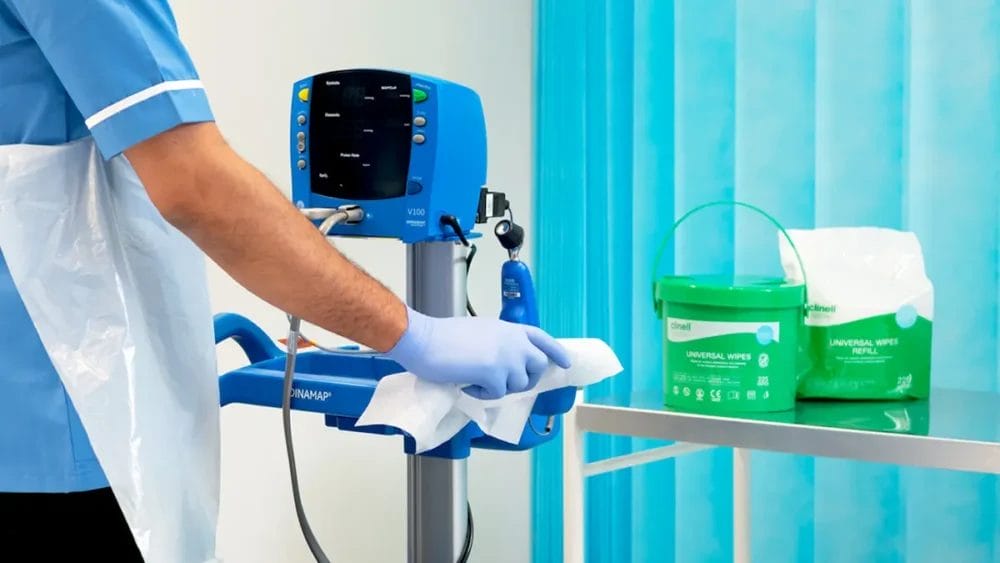Posted
14th December 2021
Events and Exhibitions
The 2nd Clean Hospitals Digital Day was hosted on 7th December following on from the success of initial day earlier this year. Environmental decontamination, air treatment/purification, sustainability and their role in keeping hospitals clean, were all on the agenda with speakers from across the globe.
Lessons Learnt from the REACH study – Prof. Brett Mitchell and Prof. Greg Whitley
The day opened with Brett recapping on the REACH study which concluded that product rationalisation and training accompanied by audit and feedback improved routine and discharge cleaning. This led to a statistically significant reduction in vancomycin resistant enterococci (VRE) infections and reduced costs correlated to reduced hospital stay. Brett reflected that the REACH study had resulted in various additional publications and that investing in environmental cleaning staff is invaluable given the outcomes from REACH. Greg discussed methods for assessing cleaning monitoring methods such as Adenosine triphosphate (ATP) and Ultraviolet (UV) fluorescent markers. ATP is easy to use but there are issues with variability and sampling, for example if you swab a wheelchair to measure ATP, where do you sample it? This resulted in further research from Greg’s group to generate an algorithm to improve data reliability which was able to provide real time discrimination between cleanliness levels and improved certainty of surface hygiene.

Hospital Hygiene, how to keep people safe – Dr. Phil Norville and Dr. Evonne Curran
I was delighted to team up with Dr. Evonne Curran in our GAMA Healthcare sponsored symposium. Evonne and I focused on the importance of effective environmental decontamination, splitting the session into 2 key themes:
- The evidence and role of the environment in transmission of healthcare associated infections (HCAIs).
- The solution, examining the process and viewing decontamination as a system.
We discussed how infectious diseases are of global significance with diverse challenges around the globe and illustrated the human and financial impact of HCAIs, discussing how a recent modelling study estimated the costs in NHS England alone to be £2.7 billion per annum.
Moving to the environment we demonstrated how microorganisms that cause HCAIs can contaminate the environment from infected or colonised patients and can survive in the environment for prolonged periods of time. Evonne discussed the continuum of contamination, exploring the complexities that need to be considered when examining an environmental decontamination system. Environmental decontamination should be viewed as a system which includes people, equipment, the environment, and methods (see figure). These systems also require intelligence and feedback to ensure they are working to maximize efficiency.

Evonne finished her session discussing a quality improvement study in Scotland, which aimed to standardise decontamination procedures. GAMA have blogged about this study previously, “Improving Hospital Cleaning & Disinfection“, but in summary a rationalisation of products accompanied by staff training and education resulted in a significant improvement in the time taken to decontaminate equipment and an improvement in the number of healthcare workers trained in decontamination.
Air Filtration and Recirculation in Healthcare Facilities – Ehsan Mousavi and Emmanuel Vanoli
Ehsan explained randomised research investigating the role of air filtration is impractical due to ethical constraints and that there are frequently various confounding factors to consider. However, mathematical modelling shows there is a linear relationship between air change rate and decay rate, demonstrating that greater numbers of air changes is beneficial. Ehsan drew attention to a systematic review examining the role of air filtration in a COVID-19 outbreak which concluded there was substantial evidence (of a certain quality) that contaminated air can result in disease spread and a combination of air filtration and air recirculation can reduce the risk. The key take home message was that if you only have one HEPA filter to put it close to the patient the maximise efficacy. Emmanuel went on to demonstrate how simulation software could be used to track aerosol movements and to examine the impact of air filtration. Also, that the placement of air filtration units is important, especially the interaction with heating, ventilation and air conditioning, (HVAC) systems.
Final thought on sustainability
The day finished with an interesting discussion around sustainability, outlining there is a need for innovation to deliver new ways to produce sustainability alternatives to decontaminate the environment and keep hospitals clean and safe.
Overall, it was a pleasure to present at the Clean Hospitals Digital Day, congratulations to the organisers and speakers for putting together an insightful series of talks and discussion. Finally, a big thank you to Evonne for joining me in GAMA’s sponsored session.
SHARE THIS ARTICLE
Tags
Latest News
Embracing sustainability and cost savings: The journey of Clinell Indicator Notes to paper-based solutions
At GAMA Healthcare, we’ve always prided ourselves on being at…
Introducing HEXI HUB: A seamless transition in our product line
We’re pleased to announce an update to our product offering…
Innovative solutions for tackling Carbapenemase-producing Enterobacteriaceae (CPE) at King’s College Hospitals
King’s College Hospital NHS Foundation Trust, one of London’s largest…
Gloves Off: reducing unnecessary plastic waste during environmental cleaning and disinfection
In this blog, Dr Phil Norville discusses the momentum-gaining ‘Gloves…





